NZTA are currently consulting on their Accessible Streets package, which is designed:
to improve safety for footpath users, encourage active modes of transport, and support the creation of more liveable and vibrant towns and cities.
Consultation closes at 5 pm on the 22nd April.
One of the many concerns NZTA is trying to resolve with this package is the growing problem of vehicles being parked on grass berms. The attention to this issue is very welcome, because our street environment presents enough dangers without vehicles moving in and taking up space in the pedestrian realm. The practice is also destructive to utilities and public property, increasing costs to Aucklanders.
However, I have serious concerns with the proposal itself (see Proposal 8).
It would give over the entire country’s set of berms – which are currently pedestrian space – as car parking space by default, to be clawed back piecemeal by the road controlling authorities.
I have taken the time to carefully review the existing rules, and to pay for an analysis by a consultant. It is my view that the existing law is sufficient for road controlling authorities to enforce Road User Rule 6.14 against cars parked on berms in the urban area.
The NZTA team involved in writing the package say they believe there is some legal uncertainty and are consulting to get a view about how to interpret and resolve this issue. Luckily they have been open to hearing my concerns.
If you are submitting on the package, please include some personal views about how vehicles parked or being manoeuvred onto berms are detracting from the goal:
to improve safety for footpath users, encourage active modes of transport, and support the creation of more liveable and vibrant towns and cities.
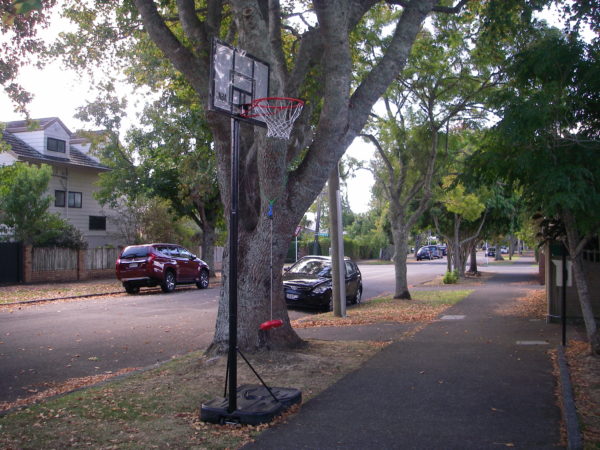
AT turns a misunderstanding into a national problem
When each of us learned to drive in the city, we were taught to park on the roadway. We practised parking next to the kerb, aiming for a beautifully executed parallel park. This is still the case: penalties are recorded during a driving license test if a driver mounts the kerb. If they do so with two wheels or cause damage, it’s an immediate failure error.
Unfortunately, a small but growing minority of drivers have stopped respecting the kerb as the edge of the realm for pedestrians to walk and children to play. They are parking inconsiderately on footpaths and grass berms. As long ago as 2012, AT were claiming they are “unable” to ticket cars parked on berms unless there are signs posted. The lack of enforcement has gradually become more obvious, encouraging more drivers to adopt the practice, making the network increasingly unpleasant and dangerous for vulnerable road users.
AT rely on an opinion that they will not release, that they say calls into doubt their ability to take action. In the eight years or more they’ve been aware of the issue, AT have chosen not to use some avenues available to them to resolve the problem.
Auckland Council has been frustrated in trying to achieve a solution. Doubt has spread to other centres, and to central government agencies (MOT and NZTA).
NZTA has not sought to review or critique the opinion that stands at the heart of AT’s refusal, nor seek their own opinion.
Unlike Auckland Transport, I am happy to share the basis for my view of the rules.

Will children have a right to play on berms every day, or only at special events? Image Credit: Bike Auckland
It is already prohibited to park on a grass berm
Road User Rule 6.14 prohibits parking on a footpath. (There is no controversy about this). I believe that vehicles are prohibited from parking on the berm , because it is part of the footpath. Here’s my rationale:
The Road User Rule defines footpath:
footpath means a path or way principally designed for, and used by, pedestrians; and includes a footbridge
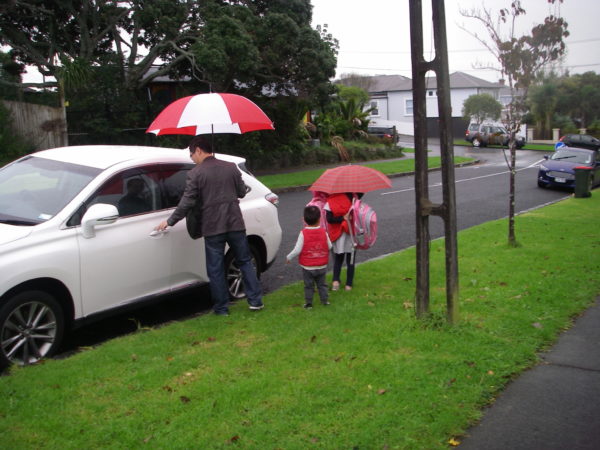
In urban areas where there are kerbs, the berm is part of the entire footpath space that has been designed principally for, and is used by, pedestrians:
- The footpath has a variety of surfaces for pedestrians: paved parts so it doesn’t get muddy, and grassy parts for softness. People will often choose to walk on the grass because it can be kinder on bare feet. It’s kinder on joggers’ joints, too, so some joggers jog along the grass in preference to the pavement.
- The footpath – both paved and unpaved – has traditionally been a place for children to congregate in the street for healthy social interaction, and to play, shoot goals, climb trees, and swing on simple swings. As kids, many of us have set up a lemonade, biscuit or grapefruit stall on the footpath, often on the unpaved berm so the paved part is clear for people walking past.
- The berm is a handy place for caregivers to stand (or sit) as they supervise children learning to skateboard, scooter or ride a trike or bike on the pavement.
- The berm is a pathway for passengers to access vehicles parked on the roadway and for people to cross the street on a desire line.
- The berm is useful for groups of people walking past each other on the footpath. The full width of the footpath (pavement plus berm) is often required, (noticeably so with the physical distancing requirements of COVID-19.)
- The berm provides safety for pedestrians through visibility. Drivers’ visibility of people on footpaths or crossing the road is reduced by vehicles parked on the berm, whether the drivers are exiting or entering properties, or on the roadway. Pedestrians will often move onto the berm to get a better view of driveways if they suspect a vehicle is about to emerge.
- The berm has vegetation and trees intended to provide shade, shelter, cooler temperatures and amenity for people as they enjoy the street, and in a vibrant, cared-for city, residents create personal neighbourhoods by tending unique and diverse plantings on the berms.
- The berm is not engineered to take the weight of vehicles. Where vehicles do need to drive over the footpath to access properties, special engineered vehicle crossings of the footpath are provided.
It’s clear that the berm is part of the “path or way principally designed for, and used by, pedestrians”. It certainly wasn’t principally designed for vehicles; it’s not strong enough for their weight, and the kerb is a barrier intended to stop them.
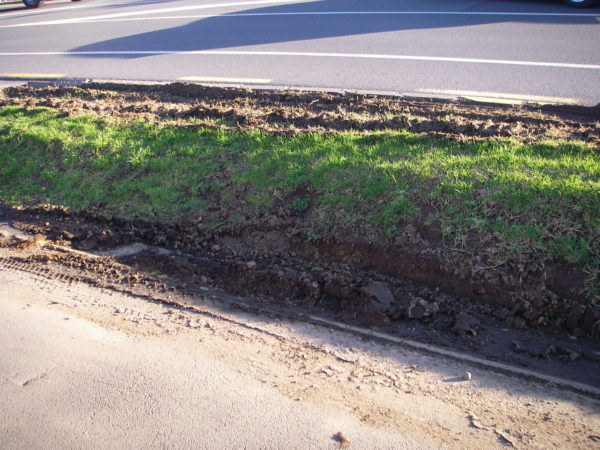
The Local Government Act 1974 includes this definition (s315(1)):
footpath means so much of any road as is laid out or constructed by authority of the council primarily for pedestrians; and includes the edging, kerbing, and channelling thereof
The footpath clearly extends all the way to include the kerb, including the berm.
Documents throughout the transport sector indicate this understanding. For example, NZTA classify the different zones of the footpath in the Pedestrian Planning and Design Guide.
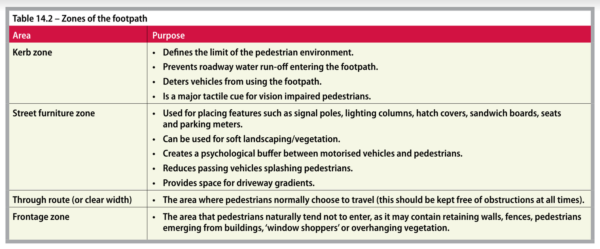

The diagrams show the “street furniture zone of the footpath” includes berms and trees, and the table says it:
Can be used for soft landscaping / vegetation
Section 14.8 also says:
Permanent planting should be sited within the street furniture zone and consist of trees, flowers, shrubs or grass
In summary, grass berms are part of the footpath. Therefore, road controlling authorities can ticket cars parked there using the Road User Rule 6.14.
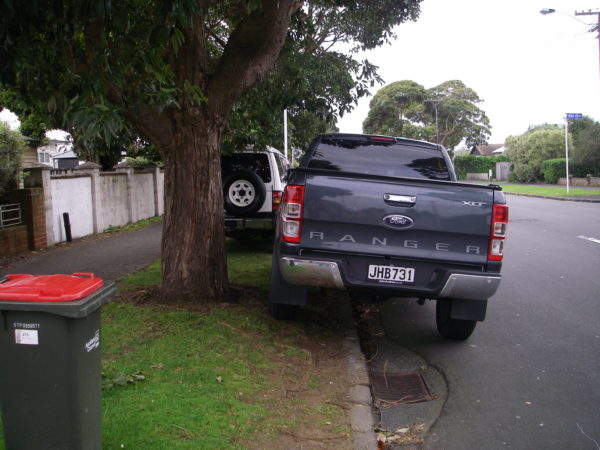
Where did Auckland Transport go wrong?
Auckland Transport’s reluctance to ticket cars on berms appears to have come from thinking the berm is part of the “road margin” rather than the footpath, and that another rule (Rule 6.2) somehow prevents them from enforcing Rule 6.14.
6.2 Parking vehicles off roadway
(1) A driver or person in charge of a vehicle must not stop, stand, or park the vehicle on a roadway if he or she can stop, stand, or park it on the road margin without damaging ornamental grass plots, shrubs, or flower beds laid out or planted on the margin.
Here’s a picture showing an urban-style footpath, complete with kerb and berm, on the left, and a rural-style road margin on the right:
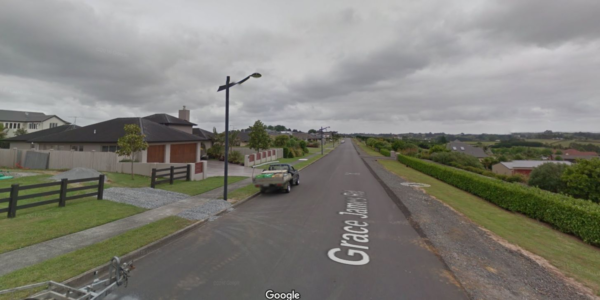
Drivers can be reasonably confident that the road margin on the right has been engineered to take the weight of a vehicle without damaging the ground, but this isn’t always the case. In the following picture, the driver might not be sure how far into the grass it is safe to drive:

The purpose of Road User Rule 6.2 is in rural areas like this, to place the onus on the driver to ensure they park safely off the roadway, but without doing any damage. It is not a clause intended for typical urban situations. Nor is it logical to claim the clause removes AT’s ability to ticket cars parked on berms in urban areas.
This is because RUR 6.2 doesn’t just allow drivers to park off the roadway and on the “road margin” where possible, it requires them to. If Auckland Transport’s advice is that the urban berm is part of the “road margin”, then every car parking on the roadway and not parking on the adjacent berm should be ticketed. For example, AT would need to ticket all the cars parked on the roadway in the following photograph:
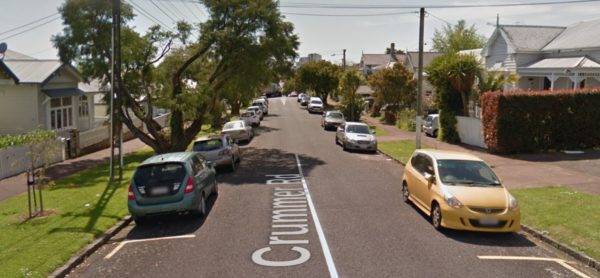
Under their interpretation, the careful parallel parking that the majority of drivers continue to practise – on the roadway, next to the kerb and berm – would be prohibited, and should be ticketed.
AT would never do this, suggesting they should not actually believe the advice they have been given.
Our problem is Auckland Transport’s lack of intent, not a lack of enforceable law. Had Auckland Transport been focused on the safety of Auckland pedestrians, they could have clarified this situation many years ago by asking for a declaratory judgement. Alternatively, they could have ticketed the vehicles, and if someone disputed the ticket, the courts could have determined the legality of the enforcement.
Auckland Transport’s lack of action on this issue has contributed to our safety crisis and low physical activity rates.
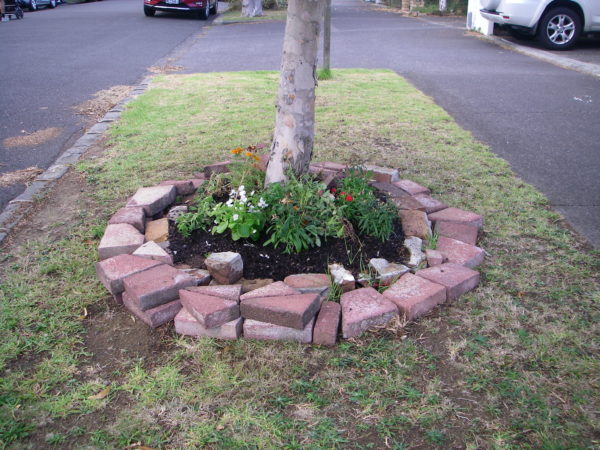
What’s wrong with NZTA’s proposal?
If proposal 8 of the package goes ahead as planned, the entire country’s set of urban berms – which are currently pedestrian space – will be available as car parking by default. The proposal changes the status quo, from being “you may not park on a berm” to being “you can park on a berm unless the road controlling authority has registered a different rule”.
Leaving registering the berms in the hands of a reluctant enforcement agency would be disastrous.

Image Credit: Jolisa Gracewood
Under the proposal, to try to stop the berm parking in a part of Auckland, we’ll have to
- convince AT that there’s an issue in that location,
- convince AT to prioritise the issue in their work schedule,
- wait while AT’s staff map and maintain the “register” of different areas and streets,
- wait while they get it through consultation, which may not be successful – it only takes a small opposition to cause AT’s progressive projects to haemorrhage,
- face the media’s articles about “the poor driver couldn’t have known that these streets were different to those around the corner, and so the ticket isn’t fair,” then
- watch as AT minimises enforcement to prevent “reputational risk” from these articles, as they are wont to do, and meanwhile
- watch as the problem spreads to areas of NZ which don’t currently have a berm parking problem, because the law will slowly change driver behaviour.
If the present rules clearly allowed parking on the berms, then the requirement for registration and consultation might be justified, because it would mean a change to basic driving practices. But this is not the case. Driver expectation has always been that berms protected by kerbs are off limits, and only AT’s poor messaging and response on the issue has led a minority of drivers to ignore their driver training.
When the problem is a suspect legal opinion in the hands of a reluctant enforcement agency, handing over all of the country’s berms to be used as parking lots by default is not the right solution.
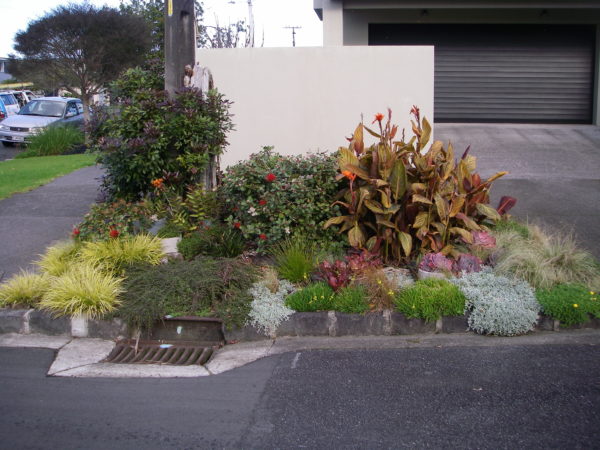
There are many diverse uses for our berms which can contribute to a liveable city. Storing vehicles is not one.
The right solution
The whole issue can be resolved in one of two ways. NZTA or the MOT could provide a simple clarification:
The purpose of a kerb is as a physical barrier to wheeled vehicles. Any grass berm between the kerb and the property boundary is part of the footpath. Therefore vehicles on the berm are parked on the footpath, and can be ticketed under Road User Rule 6.14.
This would provide no extra legal weight (and none is required) but it would effectively instruct road controlling authorities to interpret the provisions in this way. They could advise Auckland Transport’s CEO to enforce RUR 6.14, and to override the clearly misguided advice of his legal team. If a driver disputes a ticket, it is an opportunity to allow the courts to decide the matter.
Alternatively, NZTA could use the Accessible Streets package to clarify the definition of footpath, for example:
footpath means a path or way principally designed for, or used by, pedestrians, whether paved or unpaved; and, where the edge of the roadway is defined by a kerb, includes all the land between the kerbline and the adjacent property boundary; and includes a footbridge.
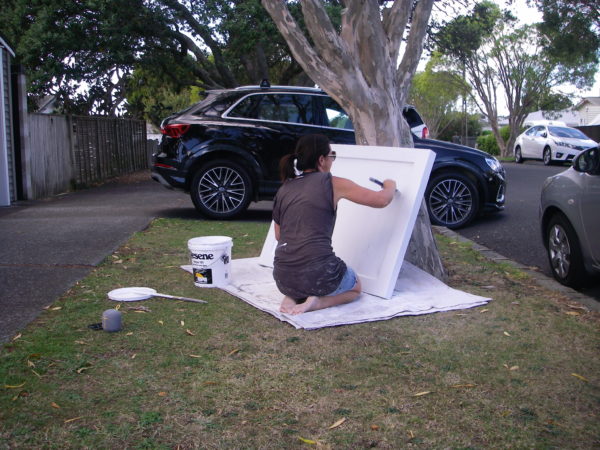
If not storing equipment, berms offer space for activities, creating points of interest – a key element in a vibrant and walkable environment.
For further information see:
- the photo narrative I’ve prepared and
- the view of the consultant I engaged to examine the situation.
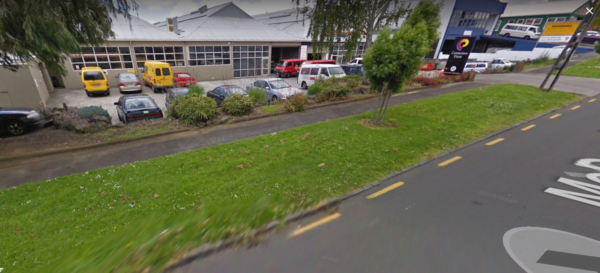
A healthy berm (above)
ruined by parking that AT should have stopped (below, Credit: Eediot, via twitter)
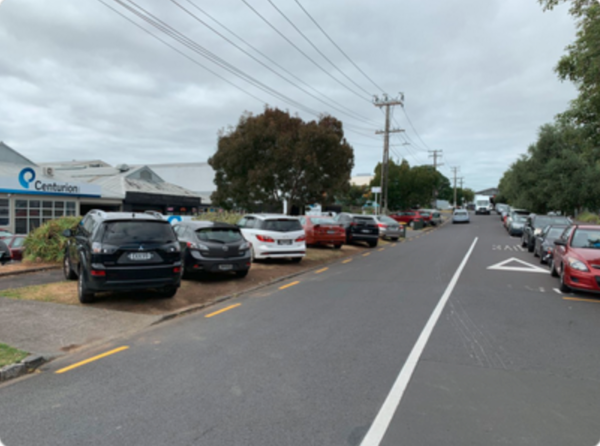

 Processing...
Processing...
I’ve been fighting this issue for a few months now on sale street.
Half the berms on the street have been paved (i.e. continuous footpath from kerb to building)
AT has interpreted that these are berms and cars can park on them. There is no distinction between the ‘berm’ and the ’footpath’ when the entire thing is paved, so it’s a complete free for all.
The building across the street Park their cars for free 24/7 on the berm/footpath.
I paid $80,000 for a car park within my building.
I forgot to mention that a whole bunch of building have painted their own parking spots onto these berms and put up ‘no parking here or we’ll tow you’
I really need to finish that letter I was writing to the local board…
Don’t stress Millennials; if you can’t afford a house just start building one on the berm. (somehow I have a feeling they would crack down on that even though it is a much better use than car parking).
Can’t NZTA just change the rule to be if the road has a curb you can’t park past that? Why is this stuff so difficult? I can understand how it gets a bit 50/50 if the road doesn’t have a curb.
But surely the best response from AT is to just plant trees in the berm in a way that there is no room to park! Why don’t we have more street trees? Or are drivers legally allowed to cut them down to park?
That’s a new twist. Incredible. Do you have in writing that AT have decided paved parts of the footpath are ‘berm’? If so, can you get a copy of it to me? This is what I mean about lack of intent and no focus on pedestrian safety.
In the photo narrative, I give an example of a fully paved footpath which was improved a few years ago to include a grass verge. When work like this is done, AT’s interpretation would be that the ‘improvement’ is a transferral of footpath space to a space that’s fair target for parking.
Nothing officially, just the behaviour (lack of tickets issued when I summon them)
I’ll email you my notes on the situation once I get my life together
Their operational guidelines are full of fantasies not based in the law. This is probably the one that tells officers not to ticket vehicles parked on the footpath if there’s a certain width of footpath still remaining.
It’s like AT haven’t heard of the Safety Crisis or of Council’s goals for supporting walking and for a liveable city.
I think Council should set someone with fresh eyes to go through AT’s operational guidelines with a fine toothed comb and remove everything with no legal base.
You should send your complaint to Donald Shoup at UCLA.
In many of the older parts of the city stormwater from roofs is discharged to the kerb by way of a shallow pipe which runs across the berm. It needs to be shallow as it discharges into the gutter. The older pipes are earthenware, the newer ones are plastic. Parking a vehicle on top of these pipes will crush them which can cause the stormwater to back up and discharge onto the property instead.
There are several examples near me of these crushed plastic pipes. They make the kerb look untidy and reduce the footpath width
Great article Heidi
Excellent work Heidi – you’ve unearthed and exposed an amazing problem for the country. And I thought that Aucklander’s problem with berms was just over the mowing of them. I had no idea that this was such an issue, nor that NZTA is collecting feedback due in just 6 days time, and nor that any result would apply to the whole country.
Tied in with this, I guess, is the practice that is common in some of the small, narrow, wiggly roads in places like Napier Hill and much of Wellington, where it has become commonplace to park with two wheels up on the footpath to get the car half off the road. Without that, either the road gets blocked or the car gets destroyed by side-swiping. Unfortunately, the footpath is then blocked for pedestrians, particularly those who are not skinny or fit enough to slide through the remaining gap. A blind eye seems to be turned towards this practice, to the benefit of those who want to park there, and to the detriment of those who want to walk there.
https://www.instantstreetview.com/@-39.485624,176.907339,90h,5p,1z
How would this proposal affect such situations?
Hi average human. Thanks for your comments.
Parking like in that example creates severe accessibility problems, and an unwalkable city. It prevents the desired modeshift towards walking. The problem has arisen because people own too many cars, due to the rise in car dependency. In large cities all around the world, if people wish to use cars, they are expected to provide their own parking (which can be expensive as land is precious) or walk a distance from carpark to the property they intend to visit.
Turning a blind eye to this illegal parking is part of car dependency – the enforcement decisions are being made to favour the ‘poor drivers with nowhere else to park’ instead of the children and other vulnerable road users whose independent mobility has been stolen.
In Wellington, where narrow winding streets mean parking on the roadway becomes an issue for traffic getting through, drivers shouldn’t park on the roadway. There already exist rules in the RUR to prevent people from blocking the flow of traffic. 6.1 says they must not park inconsiderately to other road users. 6.3 says they must not park near bends, etc, if it obstructs traffic. If ticketing in an area based on 6.1 or 6.3 doesn’t improve driver behaviour, the council can make it simpler to understand by painting yellow dashed lines.
Nor should they park on the footpath. That is prohibited in 6.14. So they need to look elsewhere for a legal park.
There’s nothing in the Accessible Streets package that improves the situation.
All that’s required is enforcement of the existing rules.
A legal interpretation that suits Wellingtonians…
No, i don’t think it is anything to do with that. Remember, Genter is an Aucklander, Twyford is an Aucklander, I think it is more a matter of not thinking through the issues in detail, as Heidi has done here.
The old Auckland City Council used bylaw controls and declared every bit to be ‘ornamental grass’ – even if it was mud. The Consolidated Bylaw book included long lists of berms as each street had to be named. Back then they had their own traffic enforcement officers who also enforced bylaws.
With such a situation having been found could a court case or similar be taken against AT (or even better the AT CEO and/or AT board) for failure to fulfil the statutory duty?
Simply filing such a case could possibly result in direct action, and a legal review by AT.
Could use a give a little page or similar as a way to raise funds, but with a statement of only proceeding if sufficient donations.
There seems to be a problem differentiating between rural, and semi rural roads where verge parking is often preferable to urban roads where there is a fundemental need to reserve pedestrian and amenity space for these uses alone, and motor vehicle encroachment should be strictly limited and controlled.
This reservation, free from road vehicle use, must be enshrined as a core component
of any thing that claims the task of making “Accessible Streets”, to be credible. Accessible to motor vehicles is the worst of last century planning. Accessible to people is required now.
Surely most of the problem could be resolved by inserting a simple definition and corresponding rule?
Something like:
Definitions
Roadside Amenity Space: All of that space, between carriageway edge kerbs, or kerbs and channel, and the adjacent property boundaries. May include paved or grassed footpaths, amenity planting and designated cycleways and authorised vehicle crossings to adjacent properties. May also include, in limited cases, any designated and formed carparks provided by the roading authority.
Rules:
Roadside Amenity Space: Motor vehicles prohibited except in designated parking areas and to cross this space, but not to park, on any formed crossings between the carriageway and adjacent properties.
Urban sprawl is a big factor.
In far away suburbs closely packed houses with 4+ bedrooms and 4+ adults each with a car have little space for parking.
More apartments close to stations and the CBD encourage more PT and biking.
Yes. And if you consider enforcement of the law and provision of a safe walking environment to be some kind of neutral, normal state, AT’s lack of enforcement on this issue has skewed the property market.
If the law was being enforced and a safe environment for people walking was prioritised, developers would need to provide as many carparks as car dependent outer suburb households require. It would be one more encouragement for developers to forget about sprawl development and look to Transit-Oriented-Development on transport corridors instead.
This is another post about how AT are skewing the property market on transport corrridors: https://www.greaterauckland.org.nz/2019/04/30/great-north-boulevard/
The number of cars per household even in central Wellington is extraordinary – my impressions based on working for the census and weekend radio use interviewing.
I found it quite common for four mid- 20s people sharing a house to have a car each.
In one case- Phillipinos from memory – both parents had a car to get to their separate rest home jobs while their adult children had cars to get to their hospo jobs. This is often a security thing for people working late night shifts. The vehicles often take up all outside space on a section and spill out on to the streets.
I am not sure it will be possible to police every parking encroachment on to berms.
It doesn’t take policing every parking encroachment onto berms (or footpaths) to nip an inconsiderate parking culture in the bud, though. And what AT have done with their public messaging has directly encouraged people to park on berms. I have told an owner of a caryard not to park his cars for sale on the berms. His reply was that he was legally allowed to. This is the level of misunderstanding that AT has created.
The response to transport poverty isn’t to create more. Allowing cars to park illegally creates modeshift away from walking to the bus stop, because it is unsafe. Yes, we need solutions for the people who need to use the transport network outside ‘normal’ travelling hours. No, the solutions don’t involve taking public space and creating danger.
jeremy – on the other hand, with my friends living in the central area in Wellington, I’m the only person out of about 20, that actually has a car (and an off-street carpark). My car-less friends always look on me with amazement as they cannot comprehend anyone in the central area needing / wanting / having a car.
This looks like a self-perpetuating effect: the on-street parking is undercutting parking built by developers (be it parking buildings, or driveways of houses). Properties with less parking will undercut properties with “enough” parking. A household looking around for a house with 2 parking spaces can actually end up buying a house with 1 parking space, and park the other car on the street.
I would add that the double garage is often used for storage or has been converted into a living area for boarders.
There is a huge incentive to use garaging for anything else but for storing cars.
Garages are an incredibly inefficient use of often crushingly expensive city land and that space can provide much more value to the landowner as increased living and household storage space.
All of this is enabled because residents get free, or minimally costed, access to that very valuable land for free to store their cars.
Talk about a market distortion.
Yes. For years we have been discussing congestion. It is not difficult to understand the causes of it and the huge costs to families both in time and money and the $millions cost to the councils for all the development, power, water, paths etc.
When you say Urban Sprawl, if you mean distance nah, but if you mean dangerous lazy infrastructure then yes.
I live on the edge of Auckland sprawl, and shops are only about 2-3km in all directions. Some small shops only 1km.
Schools are not that far too. We have like 4 ebikes in our double garage with 1 car, in our skinny house.
Even with four cars, man you can fit that all in the garage and driveway.
Fix the dangerous roads, change thinking habits so people consider their hoarding the more people there are, and fix reasons why people are living in garages. That creating living room in garage thing… I don’t really know. Improve community cohesion to use public space more?
Thank-you Heidi for this massive effort. Could we hope to expect some actual action by the board on this? FFS what part of berm parking is legal cos the berm is actually the road makes any sense?
Of course the law can be an ass, but this is clearly a massive stretch by a legal team going out on a limb to defy common sense, and, until they intervened to encourage it, common practice too. They have literally encouraged scofflaw and dangerous driving practices.
Clearly what they should have advised the board was; there is a risk that a mischievous complainant will try to have his day in court by claiming the berm is part of the road, but then that would give us the opportunity to rebut this and, either way, get a court ruling. If it goes against us then we can work to change the bylaw…. how hard would that be?
“Could we hope to expect some actual action by the board on this?”
There’s a reasonable amount of action required by the board.
I will post at some point about AT’s choice to enforce only if someone lays a complaint, which doesn’t fulfill AT’s legal responsibilities. I requested a copy of their analysis for why they have chosen to enforce reactively instead of proactively, and they have done none. So it’s not even for cost-cutting reasons; they have no analysis to show that fines wouldn’t cover the enforcement effort.
But the Board members can see the problem with their own eyes. And I posted about it before: https://www.greaterauckland.org.nz/2019/07/08/auckland-transports-parking-nonsense/
At this stage, maybe I should LGOIMA what correspondence the Board has had with the CEO on the matter?
Great article Heidi. Here in Te Atatu I am always surprised at the amount of berm and road parking at houses that appear to have heaps of off street carparking – guess they just think it is easier to hop in the car without asking a family member to move their car if they park on road or berm. Now in the time of covid 19 they seem to understand they dont need the car so much so have parked in their offroad spots.
Kind of related, I wonder how much money AT is pissing away by maintaining 11 and 13m roadways, while 7m is more than plenty for 2 lanes.
with ever increasing rates across the country , surely this is an easy way to reduce rates.
I do worry that because 50% of roading funding comes from NZTA there’s no incentive to reduce pavement area. I hope one day NZTA comes up with a standardized funding model linked to speed/road width/volumes
Thanks so much for this article Heidi. I have just submitted on it. There were some other interesting questions too, including a lot of boxes for open-ended input. The general idea seems to be to allow a lot more users of the pavement (under certain conditions). I agreed, but stated that it would be necessary to reallocate roadway to become pavement/shared space/cycleways, in order to support this safely and encourage it. The berm question did seem weirdly out-of-place and ill-thought-out in the overall context. With a bunch of submissions, NZTA ought to see their way to modifying it, I’d say, to be in line with the overall thrust of what they’re proposing.
It does seem to be 100% out of line in regard to what Genter et al are trying to do when we come out of Level 4 lockdown – i.e. widening footpaths in certain locations (not just High St in Auckland).
How about just change it to Disallow to park on berm unless Approved by local authorities on specific locations (like paved parking area which happens to be on a berm, narrow legacy streets like Ponsonby requiring limited numbers of resident permit)?
Perhaps the narrow streets should be turned into 5kph (brisk walking speed) Pedsestrians have priority, shared spaces with any parking tight against the boundaries.
Very easy to do this – given enough support in feedback on the Proposal. To clarify between road margins on which you should park and berms on which you should not, the default could simply be that all road within Urban Speed Zone should be protected and all roads in Rural Speed Zone should be governed by Rule 6.2.
Exceptions should require a Resolution and defining a space by signs and/or markings (eg. a Loading Zone). This allows for individual cases where provision can be made safely without compromising user rights.
There are some cases for ‘grandfather rights’ to be confirmed or rejected by Resolution over time (eg. a Resolution in the past has allowed a particular use).
This seems least cost and effort and easiest common understanding.
Remember: Laws are passed by Parliament but they are interpreted by Courts.
Lets be honest. Its the typical AT approach of cars-first. Their mission statement is to advance all other travel, but not infringe on the “freedoms” the private vehicle currently enjoys. Legal or not.
As a car driver myself I dont ever recall parking on a berm. I know what it is – its part of the footpath for walking, cycling, recreation – whatever. My car belongs on the road, stationary or not.
Dont get me started on reidential parking schemes. Scrap them all.
Disagree with the Residential Permitting. This is one thing that AT in principle has got right.. Residential Schemes stop lot of commuters piling into the inner suburbs. The biggest downfall currently is that residents are not being charged for the actual value of the public land, that their private asset is stored upon. $70 is far too low!! $70 per year might rent you a square centimeter of real estate in Herne Bay.
If they were charged appropriately for the real estate cost, and with an eye to the other uses the land could be put to, including all the public health benefits of safer active travel… how many people would pay that cost? And would you be foregoing entire stretches of kerbside cyclelane potential, or wider footpaths, for just a few cars?
I’m happy with $70 a year. However, they should be given to the current resident and as soon as that resident moves out, the permit is revoked. That way, they are an interim solution for people who live in the area and have cars, but no off-street car parking. Any person moving to the area then does so knowing that they can’t expect on street parking unless they want to pay a market rate.
@Sailor Boy – Why would this be a sensible thing to do. Sounds like admin fuelled bureacracy to keep track of such a scheme. Also why does a land owner have any greater claim to adjacent public land than anyone else?? In Auckland most of the Residential Zones are high income areas. This would be a very socially regressive move…
As Heidi points out if the proper market rate was charged. Then families would think about getting rid of their 2nd or 3rd car that just sits out on the street, making it difficult for members of the public to use the underlying public land…
One more comment. I’ve often thought someone should explain parking policy/transport generally to someone like David Seymour MP for Epsom. This issue is actually classic ACT fodder. i.e user pays to derive a more efficient outcome. Dave-o – hope you’re reading
I’ve been disappointed in young Green-Blue politicians on this point, too. Market-led environmental action stops short of reducing the right to use public space for parking, it seems.
Apologies Kintyre Kid – I meant I would scrap “free” residential parking schemes.
I’d prefer to have everyone paying a commercial rate tomorrow, but could live with Sailor Boy’s approach, but for a set period (say, 6mths). Give everyone a chance to make other arrangements.
I like sailor Boys idea it would be interesting if the real estate value would drop of houses, quite possibly but it may increase with the increased amenity of the area over time.
Great post & comments Heidi and many good comments by others.
Yes like the idea of turning the law in reverse where signage is needed for any exceptions to allow parking on berms in very rare situations.
Also like the idea of the cheap car parked on berms everywhere to illustrate the point.
Heidi – Have their been any cases on this matter. Either in Auckland or anywhere in the country? Hell, some common law guidance from overseas might be worth looking at.
It seems to me AT is scared to try and test this in Court… Surely that would be the right thing to do here…
Legal opinions are just opinions… Get it in front of a Judge.
With AT not issuing tickets it has been very hard to find a case to put to the courts. Here’s one of the Q and A’s:
“Q: (Please provide…) If the information is not otherwise provided in response to question 7, a reference to any court cases that have influenced AT’s policy on enforcement of parking on berms, and the legal opinion on which AT’s policy has been based.
A: There are no cases that went to the Ministry of Justice that have influenced the change in policy of Parking on the Berm, all legal opinions are privileged and cannot be disclosed, therefore your request for information is refused … as the information does not exist.”
The situation should have been resolved through AT listening to reason, but there is a very strange balance of power in the organisation.
Hopefully it will be resolved now, as NZTA should have no interest in introducing new regulations that are both unnecessary and complicating.
No cases, so this has never been tested!! My giddy aunt, that is horrendous.
I think AT is probably not issuing tickets because the Legal Team is scared of challenge… Doesn’t seem like they’re acting in their client’s best interests either; which is presumably something along the lines of safely managing the transport network and protecting the interests of the greater good.
Further… Why would AT not choose to waive its privilege? Given there are no cases, litigation privilege can’t be hidden behind.
So AT presumably should be able to waive its own solicitor client privilege… Their is a common interest here to understand why the decision has been arrived at which you would think gazumps any right to solicitor client privilege remaining when it is a matter of such public interest.
Sounds like some extreme risk aversion. going on… In house Legal @ Govt departments should be required to test a set amount of contentious matters per year…
The idea that you can’t lose if you don’t play is incredible short sighted and does little to assist with a strong democracy. Go to Court!!!
Perhaps a class action civil claim that AT is breaching its duty of care to ensure safe urban environments is in order… The loss/niusance suffered would be the loss of the ability to reasonably enjoy the area of land between the footpath and road edge…
P.s – Obviously some Kafka fans writing those replies…
The question of legal privilege is before the Ombudsman now.
And yes, I’ll consider all options once I know the outcome of this package.
Unless the legal team have been instructed to find reasons to avoid parking enforcement, which would be very hard to fathom, then we have to ask why the board took their advice of some risk here as a veto.
Identifying and weighing up risk is a key role for directors. Sometimes, it’s best to let legal action happen and have the court clarify the law.
Though it still seems unlikely that the court might agree that the berm beyond the curb is indeed still the carriageway. But either way it would then be clear.
Possibly even less likely than someone taking the case; people parking on the berm would take getting a ticket for it as fair enough, I’d have thought.
You’re spot on, Chris.
The question is, has AT raised the issue with the Board? You would think, given the risk their decisions have put pedestrians in, that they would be required to.
Similarly, has the Board raised the issue with AT? You would think, given their responsibilities, that they would be required to.
But I actually don’t know the answer to any of this.
You’re saying people can’t put their cars on the berm, but then you show photos of people putting basketball hoops, swings and gardens on the berm, and even someone using the berm to paint a door! You can’t have it both ways, it’s either to be used by people as they like or it isn’t.
I use the berm outside my place to store three large rocks, which tends to prevent anyone else from storing their cars there. Perhaps we should just put bias aside and let residents use the berm as they like, be it a car or a basketball hoop?
Geoff, I wondered who was going to say this. It was you. Hmmm.
A vibrant city has people doing things. Being active. Making social connections. Being artistic. Living. Temporarily using public space. I don’t support any particular use of the berm for activities. I put the pictures there for inspiration. People need to work things out with each other, like a mature society does.
We don’t need a whole set of pristine berms, never used. They are public space, for public uses.
If you think storing a metal box has any kind of equivalence to the richness of human activity, that’s where the bias lies.
Down in Taumarunui, you may not have this car parking problem. And I know from previous comments that you seem unperturbed by the shocking rate of DSI/km walked that we have in Auckland, stemming from both our dangerous transport network and the low rates of walking that we have.
Low rates of walking, btw, stem from both the dangerous environment AND from not having enough points of interest along the way. It’s called walkability.
You also haven’t seemed particularly concerned about the fact that our children are actually stunted in their development – cognitively, socially, physically – because of the loss of independent mobility due to our transport environment.
Probably you’re not concerned because you’re not in Auckland and not connected to our issues.
That’s a little mean on Geoff.
The post makes the point that this can become an issue for all of NZ, therefore it’s a bit disingenuous to suggest someone from Taumarunui isn’t concerned, just because they are not from Auckland.
I think the whole berm thing needs to be clarified. People should not use them as extended parking, but equally you shouldn’t put up swings for your kids as an extended back yard.
The metal box and the swing set both the add to the richness of human activity, but the metal box should be in the garage or safely parked on the road. Not across the footpath while you paint a door on the berm.
Maybe part of the problem is the council insisting that residents cut the grass. That kind of implied responsibility is growing a feeling of entitlement.
Yeah it was mean. Sorry Geoff. I actually agree with you on a lot of things. There have been times when you haven’t seemed to understand the substandard conditions for vulnerable road users in Auckland, hence my snark. But it was rude.
Heidi. There was no reason to attack Geoff for his opinion which is just as valid as yours.
I think your are severely overreacting in suggesting that people parking on berms prevents people walking stunts people’s growth etc. People parking over footpaths does and should be policed. In many places people parking partially on a berm provides more space on the roads which actually increases safety for venerable road users (ie cyclists). Of course your opinion is that the evil car owner shouldn’t park there at all. My opinion is that they should.
That children’s development is stunted by the traffic environment reducing their independent mobility is well-evidenced. Vehicles parked on berms is only one element of this, but there’s no reason to suggest it is not significant. Research shows that parents are acutely aware of the danger from children not being visible, from children having to share spaces with moving vehicles, and from children having difficulty crossing roads. Parking on berms worsens each of these things. It also degrades and removes the space that was play space. And research shows that children themselves, when brought into neighbourhood co-designing projects, consistently rate traffic as something they hate and wish to remove. From one such study:
“Flying cars were envisioned to allow more space on the ground for playing and socialising… ensuring that people of all abilities could access public spaces… At the core of their ideal environment was a place where both people and nature were connected and well cared for; with plenty of animals in the parks, birds in the sky and streets filled with trees and flowers for everyone to enjoy.”
Given all this, I think you’d need to show why parking on the berms is not a contributor to a loss of children’s independent mobility (and thus of stunted development.)
“people parking partially on a berm provides more space on the roads” No. The research shows that the strongest determinant of parking demand is parking availability. That is, increase parking supply by allowing parking on berms, pushes the demand for parking up, so more people will park on the roads, reducing safety further. To understand this, you’ll need to understand how car dependency works.
I would argue that car dependency comes from poor provision of travel choice, mainly public transport but also safe cycling and walking infrastructure. I’ve never come across the idea that provision of parking space drives car dependency, I would have thought it was the other way round?
It’s not so much the ‘provision’ of parking as the legal requirement to provide parking, usually more parking than is required.
Imagine if high schools were legally required to provide cigarettes to students, even if they also provided lots of chewing gum. Do you think they’d have a tobacco dependency problem?
There have been a number of posts about parking leading to car dependency, David, over many years. Here’s just a few: https://www.greaterauckland.org.nz/tag/donald-shoup/ This video is good: https://www.greaterauckland.org.nz/2017/10/23/video-high-cost-free-parking/
In https://www.greaterauckland.org.nz/2019/09/05/less-parking-please/ I quoted recent Melbourne research:
“Parking can directly compromise the adoption of active and sustainable modes of transport.
Firstly, free and easily accessible parking contributes to induced driving and car ownership. For example, researchers from Oslo’s Institute of Transport Economics found that access to private household parking facilities triples the likelihood of car ownership, whereas increasing the distance between parking and destinations reduces car mode share…
Secondly, on-street parking can directly compete for limited road space, inhibiting the ability to reallocate street space to improved pedestrian or cycling infrastructure (such as bicycle lanes), or to create priority lanes for road-based public transport (such as buses or trams).
Additionally, on-street parking spurs congestion from “cruising” for parking spaces, and movements in and out of spaces, as well as increasing the risk of “dooring” cyclists.”
Another point, Stu. “In many places people parking partially on a berm … your opinion is that the evil car owner shouldn’t park there at all. My opinion is that they should.”
One point I didn’t have space to address in this article is that we’re only talking here about the ability of road controlling authorities to enforce the rules. There is no question about legality. It is prohibited to drive on the berms anyway, hence it’s not legal to park there. See RUR 2.14:
A driver must not drive a motor vehicle on a lawn, garden, or other cultivation adjacent to, or forming part of, a road.
This is probably a rule enforceable by the police, not the road controlling authority. Your ‘opinion’ that people ‘should’ park there is a recommendation to do something that is prohibited.
Heidi. I am happy to back my opinion that people should be able to park on berms (but not block footpaths), which as you say is prohibited by some law. There are many things that are prohibited that many people ignore. It is not a case of all rules are meant to be broken but some area. Some of course GA have campaigned to overturn. e.g. riding bikes on footpaths, not wearing bike helmets, cyclists crossing on ped signals or treating red lights as orange.
BTW, I got a ticket from AT for parking in my driveway between the footpath and the roadway (along with everyone on my street). This was a long time back. You will be pleased to know I got off the ticket. Mainly when I queried the reward / quota system in place for the wardens at the time and the practice of patrolling a street where there were no parking restrictions. Auckland City council had just published ticket stats and the area I was in had one of the highest number of tickets yet at the time had only a couple of street with any restrictions.
As for people parking on berms stunting children’s growth, that still makes me laugh. Now where is that 5G tower that has been causing Covid19….
“Evil car owner”…zzzzz.
Stu’s story is just full of inconsistencies.
There is a footpath on this street, therefore, there is a parking restriction.
Stu notes that Auckland City Council had just published parking ticket stats for the streets, which means that berm parking is illegal (as it was through all of Auckland City), that’s another parking restriction.
Thirdly, he says that AT ticketed him, yet Auckland City Council had released the ticketing stats. Which was it? Those organisations hve never existed at the same time.
Also, that berm parking discourages walking independently which stunts personal grownth in children is indisputable. I can’t believe that anyone would try!
I don’t understand an aversion to enforcement officers just “strolling the street,” when we have the second highest DSI per km walked in the OECD countries studied by the ITF.
As the NZTA Accessible Streets package says, “Rules form part of New Zealand law and compliance is required.”
Our deficient environment and enforcement practices are systemic problems that are a cause of our high traffic trauma rates. This is people we’re talking about. But some people resist change to each element of the system.
I suppose facing the fact that children are affected by this system, and the attitude that retains it, is probably quite threatening to some people.
Silor Boy, yes it was Auckland City so not AT. Sorry for the confusion. At the time, ACC admitted that the warden was over zealous in the ticketing of everyone in the central city street and let everyone off, partly to avoid some bad publicity. The tickets were for parking on the paved part between the street and footpath, while leaving the footpath clear, so not the grass berm as such.
Why not just start parking older Japanese cars on berms in Parnell and Herne Bay (to illustrate the stupidity)? The law will get changed in a week to make berms public space.
+1, I’ve always thought of doing this in a few spots. Get the cheapest car that will pass a warrant and all but dump it somewhere. Or get a trailer and park it on street with planter box tied to it.
Heidi – There are heaps of places in Auckland where you can have an interesting walk. By the way, I got ticketed about three years ago for parking on the berm outside my house. However, who decides where the urban area finishes, and the rural area starts where you are legally obliged to park on the berm, and why isn’t the boundary signposted – just wondering.
Tell me about the ticket, Evan, please. On what grounds did they ticket you?
Statistics New Zealand define urban areas, these are use for the enforcement of other laws too. You could also do something like saying any road with speed limit of 50km/h or less is urban.
The council (or in Auckland’s case, AT) has the power to create bylaws making an area an “urban traffic area”. Anything else counts as rural. The boundary doesn’t have to (and usually doesn’t) match up with any other legal boundaries. Auckland’s current urban areas are: https://at.govt.nz/media/1979639/schedule-1-urban-traffic-areas-maps-compressed.pdf
The main purpose is deciding whether an area’s default speed limit is 50 or 100, but it’s possible it could be used for other things like this.
Heidi, thanks for your good work on this.
For us it seems a great business opportunity. Living near the town centre our street is always clogged with cars – why wouldn’t it be, it’s free parking. And people are always looking for parking.
As it looks as though I am working from home for the forseeable future I have the time to manage a parking venture. I am thinking that I will park our cars on the berms and rent out the space left vacant. Just what is the berm? We have an area between the road and the footpath and another area between the footpath and our boundary – can I use all of that?
As it starts to rain more, if it ever does, can I dump sand on the berm to ensure vehicles don’t get stuck? If the business takes off I guess I can use neighbours’ berms – can you park on any berms?
Can I erect advertising signage on the berm? I guess from the example of Sale St I can prevent people parking on our berm without paying?
Roll on the end of lock-down – I am good to go.
Only just seen this. I agree that there is a problem that needs addressing (cars parking on berms), but I do not agree that the grassed area is part of the footpath – grassed berms were created as amenity strips and also have value as “permeable surface” to allow rainwater to recharge the water table – in urban areas impermeable surfaces (buildings, roads, paths, etc) predominate so having at least some permeable surface is increasingly important. As you say, the real problem is that AT has been given some seriously defective legal advice to the effect that enforcement action (i.e. infringement notices leading to prosecution) would be legally challenged and might fail if they do not have signs at regular intervals down every street in the city (every 20 metres perhaps) stating that it is illegal to park on the adjacent berm. As you point out, the default rule should be no parking on a grassed berm where it is clearly separated from the sealed road surface by a kerb edging. Part of the problem is that this is an urban issue – when Auckland Council delegates raised the matter at the Local Government NZ annual conference last July there was very strong opposition by rural and small town delegates (who voted the remit down) as they condone and even encourage parking on their berms for reasons pointed out above. Auckland Council will put in a strongly worded submission on the proposed rule change, seeking legal clarification of the rules so that they do not need to erect a forest of signs telling motorists the bleeding obvious. 50 years ago I recall seeing a curious book – the City Council bylaw prohibiting verge parking throughout the city was a very fat document as it listed every street in the city with a berm without requiring 10,000 signs. If this is what is required to resolve the issue with enforceable rules then it could easily be done on line. Hopefully, common sense will prevail.
Hi Graeme, on the topic of berms being part of the pedestrian realm, planners make the overt decision not to put nature strips for rainwater permeability in the middle of roads, which could provide an excellent opportunity for larger canopy trees. One of the reasons they give for not doing this is that by providing the strips at the sides of the streets, the berms being part of the footpath space provide pedestrian amenity.
Hey Heidi,
At the moment the legislation is written in such a way as to allow you to park anywhere unless it is expressly prohibited. We used to half joke that you could probably drive into the Council foyer and you wouldn’t get a ticket because there were no signs up to say you couldn’t.
The legal solution to this is to flip the legislation, make parking in the road corridor illegal by default and then define the exceptions. This will require RCAs to make a conscious decision as to define where people are permitted to park rather than trying to pass bylaws, parking resolutions and put up signage to ban parking in response to people finding loopholes.
Also just to note there is grass berm on Fanshawe St directly outside the AT building, I’ve always wondered if you could get a ticket for parking there?
Please don’t change the definition of footpath to require a kerb, this makes it way more difficult to retrofit existing streets with kerb paint outs.
Benidorm, yes, swapping things over so you can only park in marked parking spots is part of that ‘other universe’ that I sometimes dream about. But it’s good to remember that places with those laws started out like us.
I had thought about that last point. If you check my wording in the two suggestions I make, neither of them limit footpaths to only those places defined with a kerb. If NZTA do agree with my rationale, I hope they get the wording right.
There’s a wider issue about modern kerbless streetscapes. I acknowledge they have a number of accessibility and safety benefits, but AT’s reluctance to enforce the parking rules mean they’re not currently suitable for Auckland. Which is sad, but I guess there’s an order in changing the driving, designing and enforcement culture side by side. If you do the kerbless streetscapes before the driving and enforcement culture have changed, you just get cars dominating the nice streetscapes, and damaging fixed street furniture like we’ve been seeing in the central city.
Hmm, disagree with your recommendations on kerbless streets. Streetscape upgrades are very expensive, get the right design in, the changes in parking enforcement can occur later. It’s also much easier to modify kerbless streetscapes, if there is no kerb you can just extend the kerb into the carriageway by installing vehicle obstructions barriers that prevent people parkign there. With kerbs you have to create a flush platform to maintain universal access like they had to do on High St which is super expensive in comparison to putting out some planter boxes like was done on Alfred St.
Yeah, you could be right. Although we’ve had a hopeless parking enforcement situation now for a whole decade. Even if this berm situation gets clarified, AT are still resisting enforcement in general. Who knows how long it’ll be before they step up?
Do you know if any research has been done on the parenting implications of kerbless streetscapes, Benidorm? As a Mum, I found my children, when wee, quickly understood the visual cue of a kerb, so I could balance protection with giving liberty.
I think research for the needs of children in transport lags significantly behind that of some other vulnerable road user groups. So I wonder when we’ll know the whole picture here about the benefits and disbenefits of kerbless streetscapes. The full consequences cannot be examined by looking at injury statistics as they are more to do with independent mobility, family relationships, stresses on parents, mental health from activity levels, and other ‘soft’ topics.
Just had a look at the https://www.nzta.govt.nz/about-us/consultations/accessible-streets site and the good news is that the deadline for submissions has changed in light of Covid-19. The new deadline is 5pm on Wednesday 20 May 2020.
Around 1980 or thereabouts I had a speeding ticket that I decided to defend. While waiting for my case to be heard the case before me involved a caravan that was parked on the berm.
Briefly, from memory, the defendant claimed that the previous local body (prior to Auckland amalgamation) had given him permission to park his caravan there. He was not living in it, just parked there between his travels. He could not produce any evidence of this permission, but based on that he had installed at his cost those concrete pavers that allow grass to grow through them on the berm that he used. After amalgamation he was told that parking his caravan on the berm was not legal, and that he had to move it. He refused and was subsequently charged. He defended the case, but was found guilty and ordered to moved the caravan. Can’t recall if he was fined.
Ancient history I know, but may be of interest.
I’m amazed Christchurch supposedly considers illegal berm parking enforceable without signs. People park vehicles on berms all the time here. I’ve complained many times through several different channels but always had no response.
The proposal does seem to be written round the wrong way at the moment (can park anywhere by default unless explicitly banned). Hopefully they switch it in the final form.
This discussion, valid as it is, misses the point. A road is a public thoroughfare, not a private carpark. It should therefore be illegal to park on any part of any road, because doing so prevents that road from being used for its intended purpose. If berms are part of the road, as many assume, then this prohibition would also apply to them.
Any vehicle parked on a road should not just be ticketed, but removed immediately (at the owner’s expense) to enable the road to be used fully for its intended purpose: unimpeded vehicle movement.
These rules are a mess, largely because of the unclear definitions.
Land Transport (Road User) Rule 2004, s1.6, interpretation: ‘road margin includes any uncultivated margin of a road adjacent to but not forming part of either the roadway or the footpath (if any).’ ‘Uncultivated’ presumably means ‘not planted with crops’, because rule 6.2 clearly contemplates that a ‘road margin’ may include an ‘ornamental grass plot’.
‘Roadway’ means ‘that portion of the road used or reasonably usable for the time being for vehicular traffic in general’. At least it’s clear that everything from the centreline to a kerb is part of the ‘roadway’.
So if we ignore the stupid lawyerspeak ambiguity of saying the road margin ‘includes’ something [so what else might it include?], the ‘road margin’ is land that may or may not exist *between* a ‘roadway’ and a ‘footpath’.
If we say that the ‘footpath’ does include the berm, then all your arguments apply. If the footpath does not include the berm, then the berm must be a ‘road margin’. In that case, as you rightly say, rule 6.2 positively commands motorists to park on the berm if it can be done without damage, and *forbids* them from parking on the ‘roadway’ in that situation.
So AT should be out ticketing everyone who parks on a roadway when it’s possible to park on the berm without damage. Which is clearly absurd.
They can’t have it both ways. They can’t say that the law allows people to park on the roadway *and* the berm (if it’s possible to park on the berm without damage).
If the law is an ass, change the law! That’s what parliaments are for. It would be easy to define a ‘built-up kerb’ (there’s no definition of ‘kerb’ in the law at present, but it’s pretty clear what is or is not a built-up kerb).
Then define ‘footpath’ as ‘all land between a built-up kerb and an adjacent property boundary’. So as far as possible the definitions relate to property boundaries, and do not try to describe physical features, which is the source of the current confusion.
You would have other rules to cover the situation where there is no built-up kerb.
This is how they do it in Queensland
Queensland State Government sets rules about parking in their Transport Operations Road Use Management (Road Rules) Regulation 2009. This states that:
a driver must not stop on a bicycle path, footpath, shared path or median strip, or the verge adjacent to a length of road in a built-up area, unless the driver –
(a) stops at a place on a length of road, or in an area, to which a parking control sign applies; and
(b) is permitted to stop at that place under Transport Operations (Road Use Management) Act 1995.
I am a lawyer in this area of law The writer is correct and whomever did the legal opinion for AT is fundamentally wrong. The courts would agree with the writer of this article. I’m baffled at the lunacy of AT.
In the auckland cbd there are streets where people drive along the footpath toward pedestrians so they can access the berm. They then park on the berm all day and night while others pay for metered parking on the street. There are serious safety concerns with allowing this to happen. Shortly a child will get hit and seriously hurt and AT will have to answer to someone as to why their assessment of this issue is not responsible and legally sound. In the meantime their red tape and lack of common sense will keep whirling around and around keeping bereaucrats in high paying jobs. Very disappointing given the ever increasing rates we pay.
Thanks, Jojo. That this still hasn’t been fixed is bad enough, but the situation is worsening. Even in 9 more months the problem has spread.
Auckland Transport is changing the driving culture with their hands off attitude, and it’s going to be very hard to improve things again.
And to give an emotive example, I pushed the pram on the footpath with my 2 week old the old the other day and had to move off the footpath as a car parked on the berm drove off the berm and along the footpath to get to a driveway so they could re-enter the road. I took a video and sent it to AT. No response. I have made in excess of 100 complaints and asked for a manger contact about this issue. No response.
It’s killing the roots of the beautiful trees on the berms. The council don’t seem to care.
The issue has got so bad now that what started out as 1-2 cars, on the odd occasion, is now 10-12 on a regular basis. I’m baffled at their lack of response. Is there something else we can do? Can we take a case to court perhaps?
Please also report it to Police at the link below. Driving on the footpath is a traffic offence, so only the police can ticket it. They are starting to prosecute people based on video evidence, but at the very least, they might go and visit the driver to talk to them. https://www.police.govt.nz/about-us/publication/community-roadwatch-form
Congratulations on the baby! You really don’t need that stress when you have a little one.
Your legal background would give you more of an idea of the chances of making improvements via a court case. It seems to me there’s a good case. When you’re not in the throes of babydom, comment again here, and I’ll try to contact you to see what options we have.
I am really disappointed I’ve only just learnt of this (a year too late).
AT are being seriously useless, and running double standards here.
If you park on the berm in a commercial area (eg outside the shopping centre) you WILL get a ticket. But if you do it in residential areas now, they are turning a blind eye. Never mind if residents can no longer safely see to turn out of their driveway.
Thanks Michael. You might have read this late but the problem’s not gone away. It seems the Accessible Streets legislation has been held up because some naive single-issue advocates let perfect be the enemy of good, and challenged it (on another issue). AT are indeed being seriously useless by relying on the NZTA process to resolve the situation when, as I’ve laid out above, that is not required.
What we need is Council leadership, with a real resolve to actually fix this city’s problems. If you’d like to put some pressure on your councillor and the mayor, it’s never too late. 🙂
I have people parking on the berm in front of my home that the council insist I maintain yet I cant do this with other peoples cars parked there, I used to work for Auckland City Traffic department and they ticketed for parking on the berm as it was a bylaw.
Auckland Transport is the most incompetent organisation in everything they do. Whole bunch of useless people. Replace all the higher ups with people who really love the Auckland. Berm parking is creating chaos in every corner of the city.
Ruins the grass and makes the area look run down and dirty. Plus can be dangerous in hard to see/busy areas with broken yellow line.
Well I’ve had an issue in Onehunga since I’ve lived here. People park outside my house on the grass, sometimes one is half on the grass and another double parked on the grass. Every weekend we get hordes parking on the streets to go to Dressmart. Fridays the Mosk across the road have a gathering in the afternoon. I spend a good 30 mins trying to tell the people parking in front of my drive and on the grass ( today a stupid guy parked on the corner! ) that it is illegal.
The road gets so busy, I’m hearing horns blasting because cars can’t get through. It’s a daily thing, but Friday to Sunday is havoc.
It’s a very dangerous, and busy spot, with a school, churches, and a lot of family and people walking around.
I sent the council an email via a form on their site ( I don’t have a copy sorry ). I explained the situation, and said I could also provide photo or video evidence. I never heard back 🙁
In the winter the grassy berm areas are just mud, only because cars park on it.
A few months back a guy on a motor bike went through the window of a car in this spot, right in front of our house! Nothing to do with parking , but just adds to the fact how busy this spot is.
I also think it’s rude for someone to mess up the grass that the council says your responsible for.
It’s also rude IMO to park in front of someone elses house …. on the grass. I often see cars parked right there by my gate and I can’t see anything else. Just a car illegally parked on the grass. That’s not a biggy, just annoying.
My thoughts on the ZNTA, is that they do what they can where it makes a profit with little effort. It probably costs more for someone to come out and issue a ticket than it does for them to put up a sign and enforce the law. Go the easy route and do nothing.
They’ve tar-sealed cul-de-sacs that don’t need it ( causing a lot of frustration ) and spend weeks filling holes that’d take anyone could do within an hour by themselves with no tea breaks with their team of 10.
I got very loud at a couple of people today, parking to obscure the footpath, and parking on a corner ( seeing cars have to navigate around this idiot to turn into the next street ). The park on the corner guy said “I’ll be back in 5 minutes” I said “I know you’re going across the road for 30 minutes. You can’t park there it is illegal and dangerous.
I’ve also tried putting nice message on car windows explaining the situation but the notes always end up in the gutter.
Oh I just remembered, there are also motor bike gangs that drive on the footpath here, to park by the local burger bar. I guess because they can’t park anywhere else, so they drive along the actual footpath where kids often walk. They can’t park on the berm when there are cars already there!
Feeling sad because I know the law will change to suit the politicians and fat scrooges in power, leaving the actual people that live in the real world to deal with the shit they pass to us.
Thank you Heidi for this write up. It’s helped me to vent and also get an idea of the bigger picture.
Dwayne
Don’t be fooled by geometry dash lite‘s deceptively minimalist aesthetic – beneath the neon glow and throbbing beats lies a challenge that will push your reflexes to the limit.